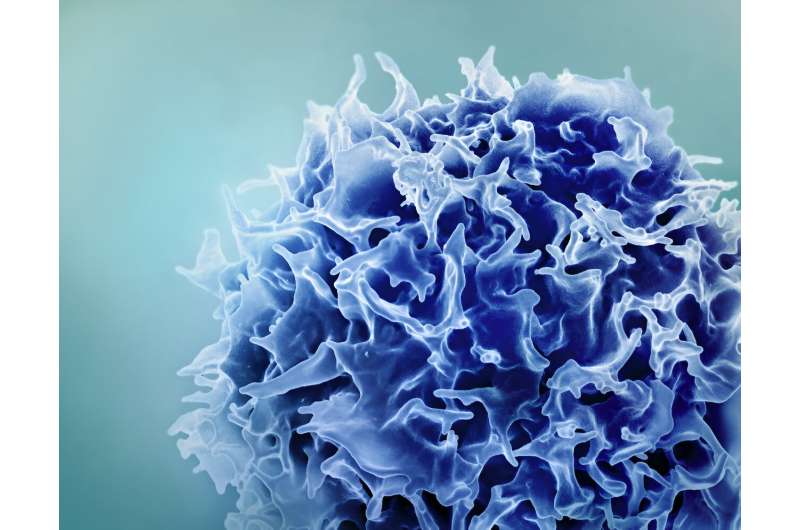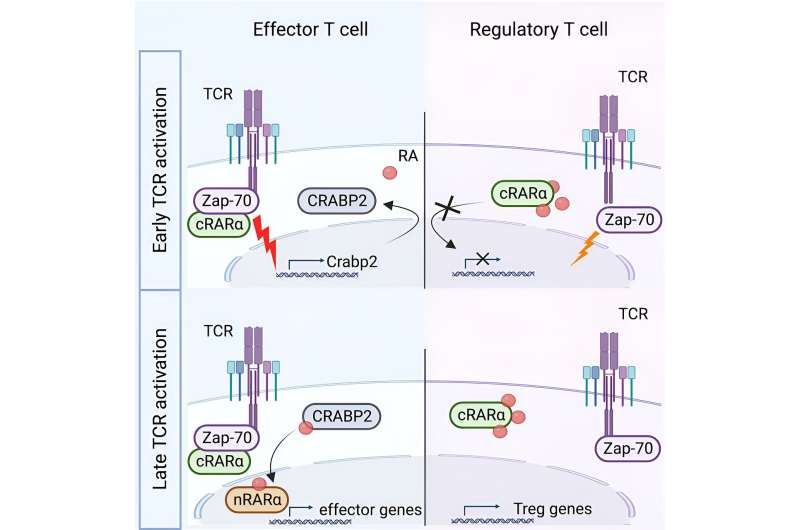This article has been reviewed according to Science X's editorial process and policies. Editors have highlighted the following attributes while ensuring the content's credibility:
fact-checked
peer-reviewed publication
trusted source
proofread
New research has major implications for controlling T cell activity

According to new research in the journal Immunity, T cells have a nuclear receptor doing something very odd—but very important—to help them fight pathogens and destroy cancer cells. This receptor, called retinoic acid receptor alpha (RARα), is known to control gene expression programs in the nucleus, but it also now appears to operate outside the cell nucleus to coordinate the early events triggered at the cell surface that lead to T cell activation.
Scientists wouldn't normally expect to see a nuclear receptor such as RARα playing this role outside the cell nucleus. And yet the new findings suggest T cells cannot begin to fight disease without a form of RARα on the scene in the cytoplasm.
"Cytoplasmic retinoic acid receptors turn out to be central for a T cell to link sensing at the cell surface with downstream signaling cascades and gene expression programs that transform the T cell to become an active fighter," says Professor Hilde Cheroutre, Ph.D., who led the new study at La Jolla Institute for Immunology (LJI) with LJI Assistant Professor Samuel Myers, Ph.D., LJI Professor Mitchell Kronenberg, Ph.D., and LJI Professor Emeritus Amnon Altman, Ph.D.
The study is also the result of a successful collaboration with scientists at the RIKEN Center for Integrative Medical Sciences in Japan and local teams at UC San Diego and the Salk Institute.
Helping T cells respond to danger
To understand this finding, it helps to picture the geography of a T cell. The cell nucleus (with its bundled-up DNA) sits in the middle of the cell. Other molecules and cellular structures called organelles float in the cytoplasm outside the nucleus surrounded by a membrane at the border of the cell (cell membrane).
Special molecules called T cell receptors (TCRs) sit on the cell membrane, where they receive messages from other cells. You can imagine TCRs as fire-spotters, the lookouts who scan for smoke from remote cabins in the wilderness. Just as fire-spotters need to alert officials to any smoke in the distance, TCRs need to quickly signal headquarters—the cell nucleus—if they detect a potential threat, such as a virus or cancer cell.
Sending that signal to the cell nucleus is critical for activating gene expression to transform the T cell to a fighter cell. But TCRs can't just pick up a phone, so how do they alert the distant cell nucleus to trouble?
The signaling process is fascinating. Once the TCR is triggered, molecules called kinases (enzymes that add phosphates to proteins) work with adaptors that tell nearby proteins to "click" together and assemble a special molecular "activation complex." This complex is called a TCR signalosome, and it comes together just inside the cell membrane. "The TCR signalosome is extremely important for mediating communication between the outside and the inside of a cell," says Cheroutre.
And although the TCR signalosome has been studied by many people for many, many years, no one had ever detected RARα in this activation complex before.
"This new finding will change the way we think about TCR signals," says Kronenberg.

Uncovering RARα's role
RARα's secret came to light thanks to the development of CRISPR techniques, advances in imaging and mass spectrometry—and years of hard work from the LJI team and collaborators.
RARα belongs to a large family of retinoic acid receptors that normally sit on control regions of target genes in the nucleus. These retinoic acid receptors recruit repressor and activator molecules that let them "switch off" or "switch on" expression of these target genes. This important job in the nucleus has earned retinoic acid receptors the title of "nuclear receptors."
Several years ago, Cheroutre and her colleagues published research showing that retinoic acid (RA), which we get from vitamin A, triggers nuclear RARα and gene expression important for the differentiation of suppressive regulatory T cells that reduce the immune response.
For the new study, Cheroutre wanted to investigate how retinoic acid controls that suppressive T cell fate, so her laboratory started to look at retinoic acid receptors, such as RARα, more closely.
The researchers were intrigued to find that RARα actually comes in two variants, called isoforms. "These isoforms are encoded by the same gene, but they differ a little bit at one end. The consequences however are more significant and lock one form in the cytoplasm whereas the other form is confined to the nucleus" says Cheroutre.
Could these two isoforms play different roles in T cells? Looking closer, the researchers realized this RARα isoform did not respond to retinoic acid and didn't even have the right equipment to function as a nuclear receptor.
"It didn't have the tools that are important for nuclear receptors, namely the ability to interact with DNA and the ability to translocate from the cytoplasm to the nucleus," says Cheroutre.
Using CRISPR gene editing techniques to modulate expression of the two isoforms, the researchers found that modulating the cytoplasmic isoform caused major problems for TCR signaling in the cytoplasm and impaired the communication with the control center in the nucleus.
RARα is in the right place at the right time
Once they knew where to look for this RARα isoform, the researchers tried to figure out what other proteins RARα interacted with. This work revealed interactions with the kinase ZAP70, a major component of the TCR signalosome.
Another important, early clue that RARα had a role outside of the nucleus came from proteomics work led by the Myers Lab. The researchers used techniques in mass spectrometry to detect a process called phosphorylation, which is when a molecule called a phosphoryl group is attached to proteins by an upstream kinase.
For T cells, phosphorylation spurs key proteins into action when a threat is near. "There are hundreds to thousands of dynamic phosphorylation events that occur during the first hour or so of T cell stimulation," says Myers.
As Myers and his colleagues examined their data, they were surprised to spot a phosphorylation event related to RARα. In fact, phosphorylation of RARα began just three minutes into T cell activation. "Because this event was that early, our findings suggest that this phosphorylation of RARα is near the T cell receptor—and it has a burst in activity right after the TCR is stimulated," says Myers.
This discovery added to the evidence that the cytoplasmic isoform of RARα is activated by the TCR instead of by RA like the nuclear RARα. Thus, this new form of RARα represents an essential component of the TCR/ZAP70 activation complex at the cell surface.
Cheroutre and her colleagues then shed light on another fascinating phenomenon in the cytoplasm. Scientists knew that RA, which is present in the blood and taken up by the T cells, is further transported to the nucleus by a molecule called cellular retinoic acid binding protein 2 (CRABP2). CRABP2 in the cytoplasm binds to RA and carries it into the cell nucleus where it activates nuclear RARα.
The researchers showed that without CRABP2, RA remains in the cytoplasm of the T cell and instead of activating cytoplasmic RARα, it interferes with TCR-activated RARα in the cytoplasm and blocks T cell activation. As a result, the T cell can no longer effectively fight infections or kill cancer cells. The good side of this phenomenon is that the interference of RA with the cytoplasmic RARα reduces the inflammatory response of the T cell. The researchers think this process may make an important target to fight autoimmune diseases and other inflammatory diseases.
Next steps for understanding TCR signaling
The new study emphasizes the importance of understanding not just a receptor's location but its special talents and interacting partners.
"Retinoic acid receptors are really 'complex formers' and it all depends on who they recruit or reject. They have the unique capacity to engage molecules and release other molecules," says Cheroutre. "Retinoic acid receptors are the 'architects' of complexes."
The current study focused on T cells, but it may have implications for understanding signaling in many other cell types. For example, the Cheroutre Lab has gone on to show over-expression of this RARα isoform in the cytoplasm of cancer cells. What is extranuclear RARα doing there? What signals does it help relay?
"Understanding the role of this receptor has such major implications for studying protective immunity, anticancer therapies, autoimmune disease, and neurological diseases," says Cheroutre.
The Myers Lab will spearhead the next steps in this research. Myers hopes to figure out exactly what RARα does in the TCR/ZAP70 signaling complex. "Does it modulate the signaling strength or duration? How does that change in signal propagate to gene expression and T cell activity?" he asks. His laboratory plans to use a "systems biochemistry" approach to further study the role of cytoplasmic and nuclear RARα in T cell activation and differentiation.
"The ultimate goal is to see if we can identify a new pathway, or set of pathways, that could be exploited to control autoimmune diseases and inflammation or enhance protective immunity to eradicate tumors or fight infections," says Myers.
More information: Alexandre Larange et al, A regulatory circuit controlled by extranuclear and nuclear retinoic acid receptor α determines T cell activation and function, Immunity (2023). DOI: 10.1016/j.immuni.2023.07.017





















